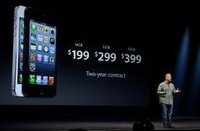iPhone 5 to recover US economy
The sales of iPhone 5 in the fall could be a tangible help to the economy of the United States of America. Retail sales of the device have long surpassed all bold predictions and made a positive impact on the overall profit of the retail segment of the market. According to experts, the American economy will get additional $3.2 billion in the fourth quarter of 2012.

Analysts give very bold predictions regarding the growth in sales of the most popular innovations of recent years. Analysts of JPMorgan estimated that in October-December 8 million iPhones will be sold. Given that the expected price of the new item will be $600 per unit (the price of the phone without a contract with a mobile operator), and the fact that the cost of imports amounted to $200 for every smartphone, iPhone 5 sales could increase U.S. GDP in the next quarter by 3.2 billion - or 12.8 billion dollars in terms of annual growth, said the Interfax.
The total amount of sales revenue is equivalent to the GDP increase by 0.33 percentage points. Under the circumstances, Apple is becoming an increasingly important customer for the companies that develop and manufacture processors for electronic devices, systems for data storage, memory chips, power management systems, Audio, Radio and Wi-Fi transmitters. No one can predict how long will this comfortable position of the company last.
Lead Analyst of Research and Risk Management UFS Investment Company Ilya Balakirev believes that any excitement about a new product is 90 percent psychology and 10 percent real need. According to him, Apple is a recognized marketing miracle, while the devices themselves, as a rule, are not anything spectacular. Most of the components for the iPhone are made by Samsung, and assembly is done in China.
The secret of the success of Apple is in the fact that they come to the market with a successful and final product before the consumer need arises. Once people had difficulty understanding why they need a touch screen on their phones, and what can be done with a tablet. But in the end, consumers did not take the product apart from other company's products. In a sense, there are no touchscreen smartphones - there is an iPhone and clones, no tablets - there is an iPad and clones. And the key here is the design and concept of the device, not the device itself. A person gets used to work with the tablet, and any other way becomes inconvenient. It does not matter what is inside. The rest is done by brand advertising in relevant target groups (through social networks, TV series, etc.) and simple psychology - "I want to have it, because ...", and there are few answers "why."
Balakirev stressed that with iPhone 5 the situation is a little easier - this is the natural evolution of the device that already has its own market and that people will buy automatically. On the other hand, it does not have any unique innovations that would favorably distinguish it from its rivals. Those customers who preferred competitive solutions to Apple products are unlikely to change their attitude. Only the devoted followers of the brand will rush to change "four" to "five" for a little larger screen.
This is the question of "how long" - how long people will continue to buy the iPhone? Probably, not for very long. The miracle of Apple will not last forever. The explosive success of the company in recent years is a masterpiece of marketing. The extremely competent promotion policy, successful work on the design and new products, Jobs' swan song and lots of luck. In the end, all of the previous years, the company as a whole was doing exactly the same thing, but did not show any miracles, occupying a tiny share of the desktop and laptop market and in demand only among the individual consumers who were willing to pay for the logo and the opportunity to distinguish themselves from the crowd. Will it be possible to repeat the success of the iPhone or iPad? This is a very big question. "
Now Apple is aimed at the consumption of about 10 percent of the global supply of the semiconductor industry. Iphone 5 production will attract over 4 percent of the supply of semiconductors in 2013, while sales of microchips for the new smartphone was 13.9 billion dollars. Analysts of IHS expect that this year Apple will spend 28 billion on microchips, which is 15 percent more than in 2011. In coming years, high demand for the company's products will bring money to the U.S. economy, popularity to the maker, and dream fulfilled to the consumers. Everyone will get what they want.
Irina Loseva
Pravda.Ru
Subscribe to Pravda.Ru Telegram channel, Facebook, RSS!


